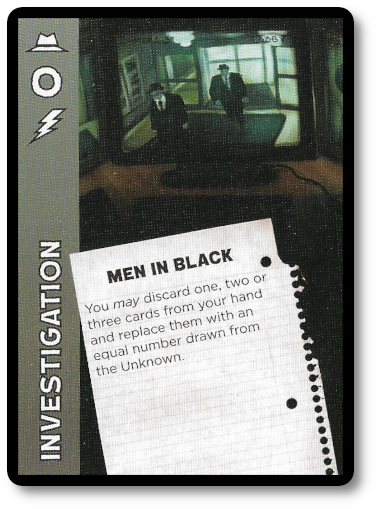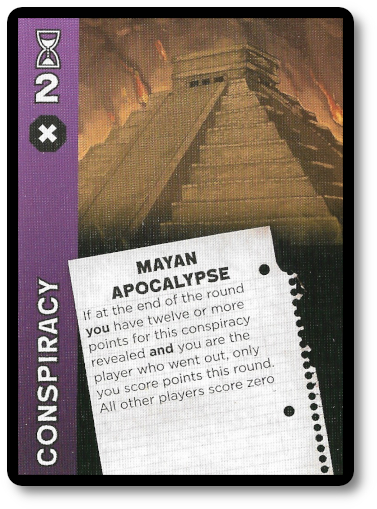 The Basics:
The Basics:
- For ages 10 and up (publisher suggests 13+)
- For 2 to 4 players
- Approximately 45 minutes to complete
Geek Skills:
- Active Listening & Communication
- Counting & Math
- Logical & Critical Decision Making
- Reading
- Color Matching
- Strategy & Tactics
- Risk vs. Reward
- Hand/Resource Management
Learning Curve:
- Child – Easy
- Adult – Easy
Theme & Narrative:
- The truth is out there! Now find it!
Endorsements:
- Gamer Geek approved!
- Parent Geek approved!
- Child Geek mixed!
Overview
American writer and public intellectual known for his epigrammatic wit, erudition, and patrician manner, Gore Vidal said, “I’m not a conspiracy theorist – I’m a conspiracy analyst.” There is a lot about our world that we don’t know, despite us making discoveries and proving theories. No matter how much we learn, there is something else to consider and study. It’s between the lines of the known and unknown, truth and assumption, that conspiracies are born and thrive. With just enough facts to strengthen falsehoods, it’s obvious why some fall headfirst into darker thoughts of mistrust towards the so-called experts. And while many of us think these types of people are “crazy,” this same group will turn around and call us “gullible.” In this game, searching for the truth is never easy to find when you don’t want an honest answer.
Conspiracy!, designed by Diane Sauer, Nick Sauer and published by Shoot Again Games, is comprised of 23 Action cards and 45 Conspiracy cards. The cards are as thick and as durable as your standard playing card. Illustrations on the cards by artists Jack Parra and Jennifer Williams are detailed and further the game’s theme. Excellent quality throughout. Not included in the game but necessary to play is a pen or pencil and something to write on to track scores.
Getting Ready to Hunt for the Truth
To set up the game, complete the following steps:
First, select one player to be the Dealer. Give this player all the cards. They now shuffle the cards and deal 10 to each player face-down. This is the player’s starting hand. After that, players should feel free to pick up their cards and look at them but keep them hidden until played.
Second, the Dealer places the remaining cards in a stack and face-down in the middle of the table. This is the draw deck for the game, which is also referred to as the “Unkown.” Finally, the Dealer flips over the top-most card from the draw deck and places it face-up. This is the discard pile, also referred to as the “Tabloids.”
That’s it for game setup. Play begins with the first player to the Dealer’s left.
Lies, Coverups, and Truth
Conspiracy! is played in rounds (or hands) and turns with no set number of rounds per game. A player’s turn is summarized here.
Step One: Draw a Card
The player must first draw a card from the Unknown or take the top-most card from the Tabloids. Then, the drawn card is placed in the player’s hand.
Note that the round will end if a player is ever required to draw from the Unkown, but no cards are available. In this way, players can hasten the end of the round if they choose.
Step Two: Play Those Cards
The following may be done in any order during this step of the player’s turn. The one caveat that must always be adhered to is that a player must be able to discard a card at the end of their turn. Therefore, if a player takes action during this step, that would result in having no cards to discard at the end of their turn; they cannot take that action.
Reveal One New Conspiracy
The first new conspiracy revealed must consist of three or more Conspiracy cards of the same type. This can be three Conspiracy cards or two Conspiracy cards and a “Proof!” Action card. However, if the player elects to play an Action card as part of their initial conspiracy reveal, they also take their single action for their turn. A small price to play to reveal the truth!

A player can only reveal one new conspiracy on their turn.
Strengthen a Conspiracy
A player may elect to strengthen one or two conspiracies already on the table. This is done by playing similar types of Consipriacy cards or a “Proof!” Action card. Regardless of whether the player is strengthening their conspiracy or an opponent’s, the cards played are set before the player who owns them. Again, if the player plays a card to strengthen a conspiracy that is an action, it counts as the player’s single action for their turn.
A player may strengthen only one conspiracy if they reveal a new conspiracy on their turn. However, they can strengthen up to two already revealed conspiracies if they do not.
If the player triggers a conspiracy’s ability by playing cards to it, resolve the ability. Note that the conspiracy’s ability only triggers once per player’s turn regardless of the number of cards played to it.
Play an Action Card
The player may play one Action card on their turn. Once played, resolve it by completing the action described on the card. There are two types of Action cards. They are “Proof!” and “Investigation.”
“Proof!” Action cards are used to strengthen conspiracies, adding points to the conspiracy that are scored later in the game. “Proof!”, if played to a conspiracy, must match the conspiracy’s type color and counts as the player’s one action for their turn.

“Investigation” Action cards represent the player’s time spent researching the conspiracies. This Action card is played, resolved, and then placed to the Tabloid discard pile.

Step Three: Discard
The player must now select one card from their hand and discard it to the Tabloids. This ends the player’s turn. The next player now takes their turn, starting with step one noted above.
Finishing Your Research
The game continues until a player “goes out” by playing their last card to the Tabolids or a player is unable to draw from the Unknown. Each other player now discards one card from their hand to the Tabloids in turn order sequence.
The round is then scored.
The player who goes out takes the cards in the Tabloid and separates the cards by color. These cards represent sensational stories that, although entertaining, distract the public and thus weaken the case to prove the conspiracy. For each card in the Tabloids that match a color of a played conspiracy, remove one card from the largest conspiracy of that type. Make sure to do so one at a time. If two or more players have the same number of cards in the conspiracy that must have a card removed, then all those players who have the same number must remove a card. In this way, the conspiracy in play that multiple players contributed to might be removed from the round entirely.
Players now count the points in the conspiracies still in play. Any conspiracy in play that has 10 or more points is considered “proven.” Proven conspiracies are worth twice more than their normal score. Each player counts the points in the conspiracies they have before them, taking into account any conspiracies that have ten or more points due to multiple players contributing to it. Keep in mind; however, the player only scores the cards in front of them. So, if they are scoring a proven conspiracy, they only double the points of their cards contributing to the proven conspiracy.
If any player has 12 or more points to the proven “Mayan Apocalypse” and is the player who went out, they score their points, but all of the other players score zero for the round.

After the players determine the number of points they scored for the round, they then look at the cards still in their hand and total up the value of each card held. This number is subtracted from their scored points for the round.
Finally, the resulting number is then added or subtracted from the player’s total points for the game thus far. In this way, a player can lose points in a round, setting them back and making it more difficult to reveal the truth!
This ends the round. The next Dealer is the player to the Dealer’s left.
Winning the Game
The game continues, with multiple rounds, until a player scores 100 or more points. Then, all the points are totaled, and the player with the most points wins the game. In an event of a tie, play one more round or as many as needed to break the tie.
To learn more about Conspiracy!, visit the game’s webpage.
Final Word
 The Child Geeks loved the artwork and the game’s quirkiness but were of a very mixed mind when it came to the gameplay. They found the actions and the shifting of the cards sometimes to be too complicated to keep track of or too disruptive. According to one Child Geek, “I like the cards and think they are funny. However, I get frustrated with the game when cards start to move or are taken away, and I cannot do anything about it.” But, of course, as I mentioned, the Child Geeks didn’t all see it that way. According to another Child Geek, “I like this game a lot. I like how you can build off other players, score points by sharing cards, and even remove cards from others to make sure you have all the points. I also like how you get more actions when people play to your conspiracy. I liked the game a lot.” When the final hand was played, the Child Geeks took a vote that resulted in a mixed endorsement.
The Child Geeks loved the artwork and the game’s quirkiness but were of a very mixed mind when it came to the gameplay. They found the actions and the shifting of the cards sometimes to be too complicated to keep track of or too disruptive. According to one Child Geek, “I like the cards and think they are funny. However, I get frustrated with the game when cards start to move or are taken away, and I cannot do anything about it.” But, of course, as I mentioned, the Child Geeks didn’t all see it that way. According to another Child Geek, “I like this game a lot. I like how you can build off other players, score points by sharing cards, and even remove cards from others to make sure you have all the points. I also like how you get more actions when people play to your conspiracy. I liked the game a lot.” When the final hand was played, the Child Geeks took a vote that resulted in a mixed endorsement.
 The Parent Geeks very much enjoyed themselves and laughed a lot when playing. They immediately understood the rules and jumped right in. One Parent Geek says, “This is a Rummy-like game, and I love card games. I liked how much control you had over your hand and the ability to manipulate others. There is just nothing about this game I didn’t enjoy!” Another Parent Geek said, “A great little card game. Fast and engaging to be sure, and not at all easy to win. But each hand – or round – felt very rewarding regardless of the number of points I scored or lost.” All the Parent Geeks enjoyed the game and gave it their full approval, proving that Conspiracy! was the truth.
The Parent Geeks very much enjoyed themselves and laughed a lot when playing. They immediately understood the rules and jumped right in. One Parent Geek says, “This is a Rummy-like game, and I love card games. I liked how much control you had over your hand and the ability to manipulate others. There is just nothing about this game I didn’t enjoy!” Another Parent Geek said, “A great little card game. Fast and engaging to be sure, and not at all easy to win. But each hand – or round – felt very rewarding regardless of the number of points I scored or lost.” All the Parent Geeks enjoyed the game and gave it their full approval, proving that Conspiracy! was the truth.
 The Gamer Geeks enjoyed the game but were not overly enthralled by it. They have played games like Conspiracy! before and didn’t find anything new in the game itself that overly excited them. According to one Gamer Geek, “A solid game, easy to pick up and play. I enjoyed it and would play it again, but only as a filler or if someone suggested it.” Another Gamer Geek said, “Yet another Rummy type game, but still a good one. I’ve played so many games that take the Rummy rules and twist them slightly. A true testament to the original card game. This new version or iteration is a good one. To truly enjoy it, you need to truly like Rummy. It worked great as a lighter game which is perfect for a filler.” When the Gamer Geeks took a vote, they all agreed that the game was solid, seeing no reason not to give it their full approval.
The Gamer Geeks enjoyed the game but were not overly enthralled by it. They have played games like Conspiracy! before and didn’t find anything new in the game itself that overly excited them. According to one Gamer Geek, “A solid game, easy to pick up and play. I enjoyed it and would play it again, but only as a filler or if someone suggested it.” Another Gamer Geek said, “Yet another Rummy type game, but still a good one. I’ve played so many games that take the Rummy rules and twist them slightly. A true testament to the original card game. This new version or iteration is a good one. To truly enjoy it, you need to truly like Rummy. It worked great as a lighter game which is perfect for a filler.” When the Gamer Geeks took a vote, they all agreed that the game was solid, seeing no reason not to give it their full approval.
 I am one of those individuals who very much enjoy Rummy (here are the rules in case you have no idea what I’m talking about) and have always enjoyed – for the more significant most part – card games derived from the Rummy game approach. There is something about this type of gameplay that I always find enjoyable and fulfilling. Mainly because there is never a chance to be stuck but plenty of opportunities to shoot yourself in the foot. It feels both competitive and semi-cooperative at the same time, which is a great place to be as a Gamer Geek who plays games with others who are not big into games.
I am one of those individuals who very much enjoy Rummy (here are the rules in case you have no idea what I’m talking about) and have always enjoyed – for the more significant most part – card games derived from the Rummy game approach. There is something about this type of gameplay that I always find enjoyable and fulfilling. Mainly because there is never a chance to be stuck but plenty of opportunities to shoot yourself in the foot. It feels both competitive and semi-cooperative at the same time, which is a great place to be as a Gamer Geek who plays games with others who are not big into games.
Conspiracy! is a fun addition to the world of Rummy games. The gameplay is fast, and the actions to be taken are meaningful. More than once, I found that I was scanning the table and counting points in my head before playing a card or thinking hard about the pros and cons of picking up the top-most card in the Tabloid. It was these little moments when I knew the game had grabbed my attention and interest that made me the happiest.
Gameplay-wise, Conspiracy! didn’t surprise or overly impress. As the Gamer Geeks noted, this is a Rummy-like game. If you know Rummy, you know about 80% of the game, with the remaining 20% focused on the fun of how the cards interact through the actions. This is where the game becomes – well – “gamer’ish.” It’s one thing to manage your hand and completely other things to take that same hand and deal out controlled chaos and confusion that benefits you. Feels good. Real good.
Do play Conspiracy! when time permits. It’s a fun game for the family, great with friends, and a rewarding filler for your gaming elitists. The only unknown mystery for this game is when you will have a chance to enjoy it.
This game was given to Father Geek as a review copy. Father Geek was not paid, bribed, wined, dined, or threatened in vain hopes of influencing this review. Such is the statuesque and legendary integrity of Father Geek.



